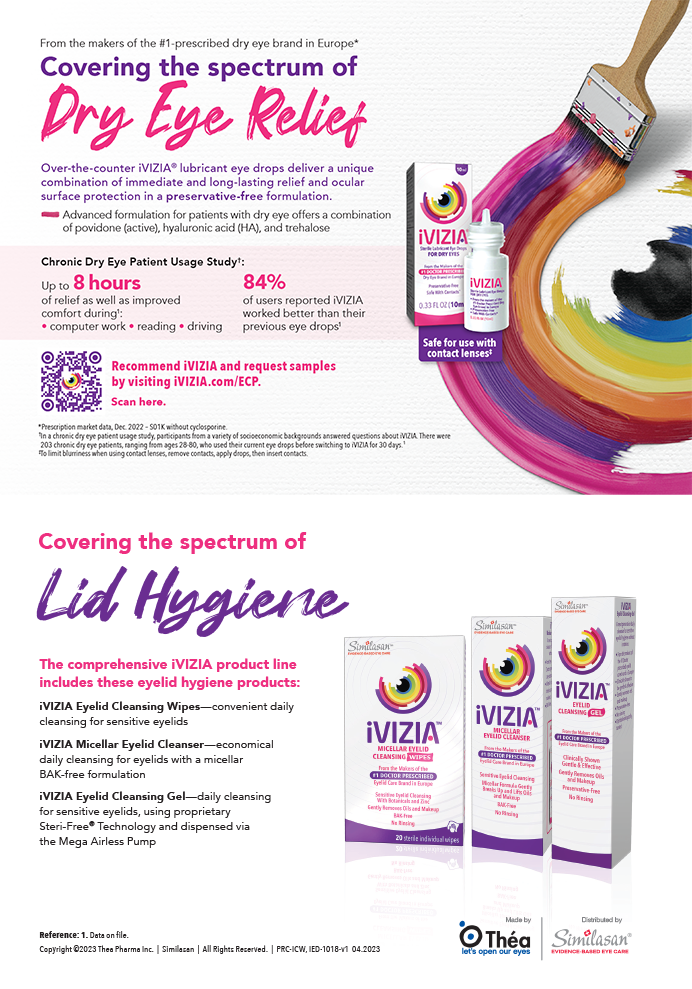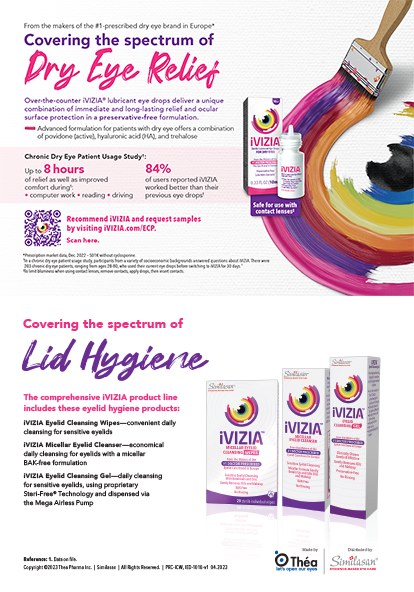

For decades, the chemical and medical industries have used UV light and riboflavin to reduce the microbial load of surfaces and solutions. For example, in blood banking, drops of riboflavin are mixed with donated blood platelets and irradiated with UV light for photoactivation to kill pathogens. Solar disinfection techniques also combine the UV component of natural sunlight with riboflavin in plastic water bottles.
Now, ophthalmologists are using UV light plus a chromophore to reduce the microbial load in the living cornea.
The corneal strengthening procedure CXL is a method that ophthalmology has adopted and adapted from other fields such as cardiac surgery and dentistry. CXL has become a clinical standard in ophthalmology to increase the biomechanical strength of an ectatic cornea, and, currently, CXL is the method of choice to safely and effectively halt the progression of keratoconus.
FROM KERATOCONUS TO KERATITIS
Evidence that the combination of UV light and the chromophore riboflavin has a disinfecting effect has led to its application in the treatment of keratitis.
The number of peer-reviewed publications on this topic is rapidly increasing, and currently, there are more than 130 PubMed entries on the topic available in MedLine. To differentiate CXL for biomechanical strengthening from CXL for the antimicrobial effect, we have coined the term photoactivated chromophore for keratitis CXL, or PACK-CXL.1
But why should we use PACK-CXL if antimicrobials work against infectious keratitis? Globally, the large majority of keratitis cases are caused by bacteria, fungi, or a combination of both. Current antibiotic treatment options such as quinolones are almost 40 years old and losing efficacy due to increasing antimicrobial resistance and a lack of new antibiotic drugs or treatments.2-4 Additionally, the costs related to administering intensive eye care and medications in severe cases are high.5
The main financial barrier, however, is not cost of the medication (the antibiotics or steroids) but rather the cost of the doctor’s examination and follow-up appointments. Patients in underdeveloped regions may have the resources for one visit, but not enough time or money for follow-up care. Compliance with treatment is another challenge because the prescribed treatment requires intense administration of topical medication over an extended period.
Therefore, any new treatment that can provide an alternative to antibiotics, effectively kill antibiotic-resistant bacteria, and be completed in a single patient encounter would address this area of great need.
A DECADE OF EXPERIENCE
Because the combination of UV light and riboflavin has been used for years for disinfection in the medical and chemical industries, a decade ago investigators looked into whether this process could be applied to living tissue in the cornea. In 2008, Iseli et al reported the results of treating five patients who were not responding to antimicrobial drugs with PACK-CXL—although it was not yet known by that name at the time.6 They found that the UV light and the riboflavin chromophore led to rapid healing of the ulcers. Although these five patients were experiencing corneal melts, keratoplasty was not needed in any of the patients after the treatment. A number of groups have since worked to optimize treatment parameters for using the PACK-CXL method so that it can be safely translated into clinical practice.7-14
The term PACK-CXL does not refer only to the use of UV light and riboflavin. Rather, the term was designed to embrace all methods in which chromophores are photoactivated for the treatment of keratitis. Another combination that has been assessed is rose bengal dye and photoactivation with green light at 523 nm.15
Still, the chromophore most often used in published studies of PACK-CXL is riboflavin, and there are now several riboflavin solutions on the market. Two of the most commonly used are Ricrolin+ (Sooft; not available in the United States) and Vibex (Avedro).
WHERE ARE WE NOW?
With other colleagues, we have published papers demonstrating that there are means to increase the killing efficacy of PACK-CXL. Although one of the means is to introduce new chromophores, several groups have showed that increasing the overall irradiance can also influence the efficacy of treatment.7,14,16-18 However, understanding the damage threshold of the endothelium is of utmost importance to establish the limitations for this treatment.
We are now at a fascinating point of transition from proof of concept to clinical application. Many surgeons have started using PACK-CXL when conventional treatment failed to resolve infectious keratitis. Nevertheless, more standardized, controlled research must be conducted and published to put this promising and fascinating treatment modality on more solid ground.
1. Hafezi F, Randleman, JB. PACK-CXL: defining CXL for infectious keratitis. J Refract Surg. 2014;30(7):438-439.
2. Mamalis N. The increasing problem of antibiotic resistance. J Cataract Refract Surg. 2007;33(11):1831-1832.
3. Jeng BH, Gritz DC, Kumar AB, et al. Epidemiology of ulcerative keratitis in Northern California. Arch Ophthalmol. 2010;128(8):1022-1028.
4. World Health Organization. Antimicrobial resistance: global report on surveillance 2014. April 2014. http://www.who.int/drugresistance/documents/surveilancereport/en/. Accessed June 28, 2018.
5. Keay L, Edwards K, Brian G, Stapleton F. Surveillance of contact lens related microbial keratitis in Australia and New Zealand: multi-source case-capture and cost-effectiveness. Ophthalmic Epidemiol. 2007;14(6):343-350.
6. Iseli HP, Thiel MA, Hafezi F, Kampmeier J, Seiler T. Ultraviolet A/riboflavin corneal cross-linking for infectious keratitis associated with corneal melts. Cornea. 2008;27(5):590-594.
7. Zhu Z, Zhang H, Yue J, Liu S, Li Z, Wang L. Antimicrobial efficacy of corneal cross-linking in vitro and in vivo for Fusarium solani: a potential new treatment for fungal keratitis. BMC Ophthalmol. 2018;18(1):65.
8. Knyazer B, Krakauer Y, Baumfeld Y, et al. Accelerated corneal cross-linking with photoactivated chromophore for moderate therapy-resistant infectious keratitis. Cornea. 2018;37(4):528-531.
9. Bonzano C, Di Zazzo A, Barabino S, Coco G, Traverso CE. Collagen cross-linking in the management of microbial keratitis [published online ahead of print January 8, 2018]. Ocul Immunol Inflamm. 2018:1-6.
10. Kasparova EA, Sobkova OI. Corneal collagen cross-linking in the treatment of infectious keratitis and corneal ulcers. Vestn Oftalmol. 2017;133(6):113-119.
11. Tabibian D, Richoz O, Hafezi F. PACK-CXL: Corneal cross-linking for treatment of infectious keratitis. J Ophthalmic Vis Res 2015;10(1):77-80.
12. Papaioannou L, Miligkos M, Papathanassiou M. Corneal collagen cross-linking for infectious keratitis: a systematic review and meta-analysis. Cornea. 2016;35(1):62-71.
13. Bamdad S, Malekhosseini H, Khosravi A. Ultraviolet A/riboflavin collagen cross-linking for treatment of moderate bacterial corneal ulcers. Cornea. 2015;34(4):402-406.
14. Richoz O, Kling S, Hoogewoud F, et al. Antibacterial efficacy of accelerated photoactivated chromophore for keratitis-corneal collagen cross-linking (PACK-CXL). J Refract Surg. 2014;30(12):850-854.
15. Arboleda A, Miller D, Cabot F, et al. Assessment of rose bengal versus riboflavin photodynamic therapy for inhibition of fungal keratitis isolates. Am J Ophthalmol. 2014;158(1):64-70. e62.
16. Amescua G, Arboleda A, Nikpoor N, et al. Rose bengal photodynamic antimicrobial therapy: A novel treatment for resistant fusarium keratitis. Cornea. 2017;36(9):1141-1144.
17. Richoz O, Gatzioufas Z, Hafezi F. Corneal collagen cross-linking for the treatment of acanthamoeba keratitis. Cornea. 2013;32(10):e189.
18. Richoz O, Gatzioufas Z, Francois P, Schrenzel J, Hafezi F. Impact of fluorescein on the antimicrobial efficacy of photoactivated riboflavin in corneal collagen cross-linking. J Refract Surg. 2013;29(12):842-845.




